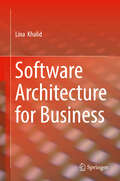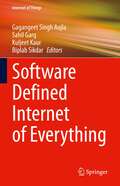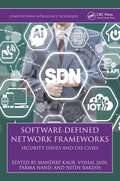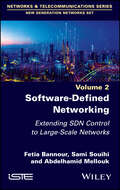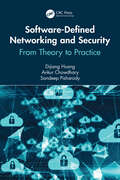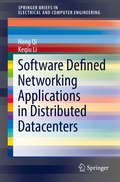- Table View
- List View
Soft Tissue Biomechanical Modeling for Computer Assisted Surgery (Studies in Mechanobiology, Tissue Engineering and Biomaterials #11)
by Yohan PayanThis volume focuses on the biomechanical modeling of biological tissues in the context of Computer Assisted Surgery (CAS). More specifically, deformable soft tissues are addressed since they are the subject of the most recent developments in this field. The pioneering works on this CAS topic date from the 1980's, with applications in orthopaedics and biomechanical models of bones. More recently, however, biomechanical models of soft tissues have been proposed since most of the human body is made of soft organs that can be deformed by the surgical gesture. Such models are much more complicated to handle since the tissues can be subject to large deformations (non-linear geometrical framework) as well as complex stress/strain relationships (non-linear mechanical framework). Part 1 of the volume presents biomechanical models that have been developed in a CAS context and used during surgery. This is particularly new since most of the soft tissues models already proposed concern Computer Assisted Planning, with a pre-operative use of the models. Then, the volume addresses the two key issues raised for an intra-operative use of soft tissues models, namely (Part 2) “how to estimate the in vivo mechanical behavior of the tissues?” (i.e. what are the values of the mechanical parameters that can deliver realistic patient-specific behavior?) and (Part 3) “how to build a modeling platform that provides generic real-time (or at least interactive-time) numerical simulations?”
Soft Tissue Simulants (Biomedical Materials for Multi-functional Applications)
by Gurpreet Singh Arnab ChandaSoft tissue simulants, essential for automotive and ballistic testing, medical, and surgical training, have traditionally relied on cadavers and animal tissues. However, their biomechanical properties change with time due to dehydration after death and the biomechanics of the animal models cannot be translated and compared with the human tissues. This book compiles various synthetic tissues used in these applications, addressing their characterization and industry-wide applications. While older simulants lack biofidelity, recent advancements in biofidelic soft tissue simulants offer promising alternatives, yet technology transfer remains limited. This book fills the gap by exploring each simulant's characteristics and current trends, facilitating their adoption in clinical and academic settings. These synthetic tissues have the potential to replace live tissues in surgical training, streamlining biosafety approvals. They also benefit academic researchers by reducing costs and time in biomechanical testing. Anticipated to be the first of its kind, this comprehensive reference book will showcase recent advancements in soft tissue simulant development, serving as a cornerstone text in tissue engineering & biomedical engineering, medical simulation, biomechanics, and related fields.
Software and Network Engineering (Studies in Computational Intelligence #413)
by Roger LeeThe series "Studies in Computational Intelligence" (SCI) publishes new developments and advances in the various areas of computational intelligence – quickly and with a high quality. The intent is to cover the theory, applications, and design methods of computational intelligence, as embedded in the fields of engineering, computer science, physics and life science, as well as the methodologies behind them. The series contains monographs, lecture notes and edited volumes in computational intelligence spanning the areas of neural networks, connectionist systems, genetic algorithms, evolutionary computation, artificial intelligence, cellular automata, self-organizing systems, soft computing, fuzzy systems, and hybrid intelligent systems. Critical to both contributors and readers are the short publication time and world-wide distribution - this permits a rapid and broad dissemination of research results. The purpose of the first ACIS International Symposium on Software and Network Engineering held on December 19-20, 2012 on the Seoul National University campus, Seoul, Korea is to bring together scientist, engineers, computer users, students to share their experiences and exchange new ideas, and research results about all aspects (theory, applications and tools) of software & network engineering, and to discuss the practical challenges encountered along the way and the solutions adopted to solve them The symposium organizers selected the best 12 papers from those papers accepted for presentation at the symposium in order to publish them in this volume. The papers were chosen based on review scores submitted by members of the program committee, and underwent further rigorous rounds of review. The symposium organizers selected the best 12 papers from those papers accepted for presentation at the symposium in order to publish them in this volume. The papers were chosen based on review scores submitted by members of the program committee, and underwent further rigorous rounds of review.
Software and Systems Architecture in Action
by Raghvinder S. SangwanModern-day projects require software and systems engineers to work together in realizing architectures of large and complex software-intensive systems. To date, the two have used their own tools and methods to deal with similar issues when it comes to the requirements, design, testing, maintenance, and evolution of these architectures.Software and
Software and Systems Architecture in Action (Applied Software Engineering Ser.)
by Raghvinder S. SangwanModern-day projects require software and systems engineers to work together in realizing architectures of large and complex software-intensive systems. To date, the two have used their own tools and methods to deal with similar issues when it comes to the requirements, design, testing, maintenance, and evolution of these architectures.Software and
Software, Animation and the Moving Image: What's in the Box?
by A. WoodSoftware, Animation and the Moving Image brings a unique perspective to the study of computer-generated animation by placing interviews undertaken with animators alongside an analysis of the user interface of animation software. Wood develops a novel framework for considering computer-generated images found in visual effects and animations.
Software Application Development: A Visual C++, MFC, and STL Tutorial
by Bud Fox Ph.D. Zhang Wenzu Ph.D. Tan May Ling M.Sc.Software Application Development: A Visual C++, MFC, and STL Tutorial provides a detailed account of the software development process using Visual C++, MFC, and STL. It covers everything from the design to the implementation of all software modules, resulting in a demonstration application prototype which may be used to efficiently represent mathem
Software Architecture for Business
by Lina KhalidThis book illustrates the role of software architecture and its application in business. The author describes enterprise architecture along with business architecture to show the role of software architecture in both areas. The place of software architecture in business is outlined from many perspectives in this context. The book outlines quality attributes and how managers can use software architecture to build high quality products. Topics include business software architecture, dealing with qualities, achieving quality attributes, managing business qualities, software product line, Internet of Things (IOT), and Service Oriented Business Architecture. The book is intended to benefit students, researchers, software architects, and business architects. Provides quick and easy access to all the important aspects of software architecture in business;Highlights a wide variety of concepts of software architecture in a straightforward manner, for students, practitioners, or architects;Presents different applications of software architecture in business.
Software Automatic Tuning: From Concepts to State-of-the-Art Results
by Ken Naono Keita Teranishi John Cavazos Reiji SudaAutomatic Performance Tuning is a new software paradigm which enables software to be high performance in any computing environment. Its methodologies have been developed over the past decade, and it is now rapidly growing in terms of its scope and applicability, as well as in its scientific knowledge and technological methods. Software developers and researchers in the area of scientific and technical computing, high performance database systems, optimized compilers, high performance systems software, and low-power computing will find this book to be an invaluable reference to this powerful new paradigm.
Software-Based Acoustical Measurements (Modern Acoustics and Signal Processing)
by Federico MiyaraThis textbook provides a detailed introduction to the use of software in combination with simple and economical hardware (a sound level meter with calibrated AC output and a digital recording system) to obtain sophisticated measurements usually requiring expensive equipment. It emphasizes the use of free, open source, and multiplatform software. Many commercial acoustical measurement systems use software algorithms as an integral component; however the methods are not disclosed. This book enables the reader to develop useful algorithms and provides insight into the use of digital audio editing tools to document features in the signal. Topics covered include acoustical measurement principles, in-depth critical study of uncertainty applied to acoustical measurements, digital signal processing from the basics, and metrologically-oriented spectral and statistical analysis of signals. The student will gain a deep understanding of the use of software for measurement purposes; the ability to implement software-based measurement systems; familiarity with the hardware necessary to acquire and store signals; an appreciation for the key issue of long-term preservation of signals; and a full grasp of the often neglected issue of uncertainty in acoustical measurements. Pedagogical features include in-text worked-out examples, end-of-chapter problems, a glossary of metrology terms, and extensive appendices covering statistics, proofs, additional examples, file formats, and underlying theory.
Software Defined Chips: Volume II
by Leibo Liu Shaojun Wei Jianfeng Zhu Chenchen DengThis book is the second volume of a two-volume book set which introduces software-defined chips. In this book, the programming model of the software-defined chips is analyzed by tracing the coevolution of modern general-purpose processors and programming models. The enhancement in hardware security and reliability of the software-defined chips are described from the perspective of dynamic and partial reconfiguration. The challenges and prospective trends of software-defined chips are also discussed. Current applications in the fields of artificial intelligence, cryptography, 5G communications, etc., are presented in detail. Potential applications in the future, including post-quantum cryptography, evolutionary computing, etc., are also discussed. This book is suitable for scientists and researchers in the areas of electrical and electronic engineering and computer science. Postgraduate students, practitioners and professionals in related areas are also potentially interested in the topic of this book.
Software Defined Chips: Volume I
by Shaojun Wei Leibo Liu Jianfeng Zhu Chenchen DengThis is the first book of a two-volume book set which introduces software defined chips. In this book, it introduces the conceptual evolution of software defined chips from the development of integrated circuits and computing architectures. Technical principles, characteristics and key issues of software defined chips are systematically analyzed. The hardware architecture design methods are described involving architecture design primitives, hardware design spaces and agile design methods. From the perspective of the compilation system, the complete process from high-level language to configuration contexts is introduced in detail. This book is suitable for scientists and researchers in the areas of electrical and electronic engineering and computer science. Postgraduate students, practitioners and professionals in related areas are also potentially interested in the topic of this book.
A Software-Defined GPS and Galileo Receiver: A Single-Frequency Approach (Applied and Numerical Harmonic Analysis)
by Kai Borre Dennis M. Akos Nicolaj Bertelsen Peter Rinder Søren Holdt JensenThis book explore the use of new technologies in the area of satellite navigation receivers. In order to construct a reconfigurable receiver with a wide range of applications, the authors discuss receiver architecture based on software-defined radio techniques. The presentation unfolds in a user-friendly style and goes from the basics to cutting-edge research. The book is aimed at applied mathematicians, electrical engineers, geodesists, and graduate students. It may be used as a textbook in various GPS technology and signal processing courses, or as a self-study reference for anyone working with satellite navigation receivers.
Software Defined Internet of Everything (Internet of Things)
by Gagangeet Singh Aujla Sahil Garg Kuljeet Kaur Biplab SikdarThis book provides comprehensive discussion on key topics related to the usage and deployment of software defined networks (SDN) in Internet of Everything applications like, healthcare systems, data centers, edge/fog computing, vehicular networks, intelligent transportation systems, smart grids, smart cities and more. The authors provide diverse solutions to overcome challenges of conventional network binding in various Internet of Everything applications where there is need of an adaptive, agile, and flexible network backbone. The book showcases different deployment models, algorithms and implementations related to the usage of SDN in Internet of Everything applications along with the pros and cons of the same. Even more, this book provides deep insights into the architecture of software defined networking specifically about the layered architecture and different network planes, logical interfaces, and programmable operations. The need of network virtualization and the deployment models for network function virtualization is also included with an aim towards the design of interoperable network architectures by researchers in future. Uniquely, the authors find hands on practical implementation, deployment scenarios and use cases for various software defined networking architectures in Internet of Everything applications like healthcare networks, Internet of Things, intelligent transportation systems, smart grid, underwater acoustic networks and many more. In the end, design and research challenges, open issues, and future research directions are provided in this book for a wide range of readers
Software Defined Mobile Networks: Beyond LTE Network Architecture (Wiley Series on Communications Networking & Distributed Systems)
by Madhusanka Liyanage Andrei Gurtov Mika YlianttilaThis book describes the concept of a Software Defined Mobile Network (SDMN), which will impact the network architecture of current LTE (3GPP) networks. SDN will also open up new opportunities for traffic, resource and mobility management, as well as impose new challenges on network security. Therefore, the book addresses the main affected areas such as traffic, resource and mobility management, virtualized traffics transportation, network management, network security and techno economic concepts. Moreover, a complete introduction to SDN and SDMN concepts. Furthermore, the reader will be introduced to cutting-edge knowledge in areas such as network virtualization, as well as SDN concepts relevant to next generation mobile networks. Finally, by the end of the book the reader will be familiar with the feasibility and opportunities of SDMN concepts, and will be able to evaluate the limits of performance and scalability of these new technologies while applying them to mobile broadb and networks.
Software Defined Mobile Networks: Beyond LTE Network Architecture (Wiley Series on Communications Networking & Distributed Systems)
by Madhusanka Liyanage Andrei Gurtov Mika YlianttilaThis book describes the concept of a Software Defined Mobile Network (SDMN), which will impact the network architecture of current LTE (3GPP) networks. SDN will also open up new opportunities for traffic, resource and mobility management, as well as impose new challenges on network security. Therefore, the book addresses the main affected areas such as traffic, resource and mobility management, virtualized traffics transportation, network management, network security and techno economic concepts. Moreover, a complete introduction to SDN and SDMN concepts. Furthermore, the reader will be introduced to cutting-edge knowledge in areas such as network virtualization, as well as SDN concepts relevant to next generation mobile networks. Finally, by the end of the book the reader will be familiar with the feasibility and opportunities of SDMN concepts, and will be able to evaluate the limits of performance and scalability of these new technologies while applying them to mobile broadb and networks.
Software-Defined Network Frameworks: Security Issues and Use Cases (ISSN)
by Mandeep Kaur Vishal Jain Parma Nand Nitin RakeshSoftware-Defined Networks (SDN) work by virtualization of the network and the Cognitive Software-Defined Network (CSDN) combines the efficiencies of SDN with cognitive learning algorithms and enhanced protocols to automatize SDN. Partial deployment of SDN along with traditional networking devices forms a Hybrid Software-Defined Network (HSDN). Software-Defined Network Frameworks: Security Issues and Use Cases consolidates the research relating to the security in SDN, CSDN, and Hybrid SDNs. The security enhancements derived from the use of various SDN frameworks and the security challenges thus introduced, are also discussed. Overall, this book explains the different architectures of SDNs and the security challenges needed for implementing them.Features: Illustrates different frameworks of SDN and their security issues in a single volume Discusses design and assessment of efficient SDN northbound/southbound interfaces Describes cognitive computing, affective computing, machine learning, and other novel tools Illustrates coupling of SDN and traditional networking – Hybrid SDN Explores services, technologies, algorithms, and methods for data analysis in CSDN The book is aimed at researchers and graduate students in software engineering, network security, computer networks, high performance computing, communications engineering, and intelligent systems.
Software-Defined Network Frameworks: Security Issues and Use Cases (ISSN)
Software-Defined Networks (SDN) work by virtualization of the network and the Cognitive Software-Defined Network (CSDN) combines the efficiencies of SDN with cognitive learning algorithms and enhanced protocols to automatize SDN. Partial deployment of SDN along with traditional networking devices forms a Hybrid Software-Defined Network (HSDN). Software-Defined Network Frameworks: Security Issues and Use Cases consolidates the research relating to the security in SDN, CSDN, and Hybrid SDNs. The security enhancements derived from the use of various SDN frameworks and the security challenges thus introduced, are also discussed. Overall, this book explains the different architectures of SDNs and the security challenges needed for implementing them.Features: Illustrates different frameworks of SDN and their security issues in a single volume Discusses design and assessment of efficient SDN northbound/southbound interfaces Describes cognitive computing, affective computing, machine learning, and other novel tools Illustrates coupling of SDN and traditional networking – Hybrid SDN Explores services, technologies, algorithms, and methods for data analysis in CSDN The book is aimed at researchers and graduate students in software engineering, network security, computer networks, high performance computing, communications engineering, and intelligent systems.
Software Defined Networking: Design and Deployment
by Patricia A. Morreale James M. AndersonSoftware Defined Networking: Design and Deployment provides a comprehensive treatment of software defined networking (SDN) suitable for new network managers and experienced network professionals. Presenting SDN in context with more familiar network services and challenges, this accessible text:Explains the importance of virtualization, particularly
Software Defined Networking: Design and Deployment
by Patricia A. Morreale James M. AndersonSoftware Defined Networking: Design and Deployment provides a comprehensive treatment of software defined networking (SDN) suitable for new network managers and experienced network professionals. Presenting SDN in context with more familiar network services and challenges, this accessible text:Explains the importance of virtualization, particularly
Software-Defined Networking 2: Extending SDN Control to Large-Scale Networks (pdf)
by Fetia Bannour Sami Souihi Abdelhamid MelloukSoftware-Defined Networking 2: Extending SDN Control to Large-Scale Networks
by Fetia Bannour Sami Souihi Abdelhamid MelloukSoftware-Defined Networking and Security: From Theory to Practice (Data-Enabled Engineering)
by Dijiang Huang Ankur Chowdhary Sandeep PisharodyThis book provides readers insights into cyber maneuvering or adaptive and intelligent cyber defense. It describes the required models and security supporting functions that enable the analysis of potential threats, detection of attacks, and implementation of countermeasures while expending attacker resources and preserving user experience. This book not only presents significant education-oriented content, but uses advanced content to reveal a blueprint for helping network security professionals design and implement a secure Software-Defined Infrastructure (SDI) for cloud networking environments. These solutions are a less intrusive alternative to security countermeasures taken at the host level and offer centralized control of the distributed network. The concepts, techniques, and strategies discussed in this book are ideal for students, educators, and security practitioners looking for a clear and concise text to avant-garde cyber security installations or simply to use as a reference. Hand-on labs and lecture slides are located at http://virtualnetworksecurity.thothlab.com/. Features Discusses virtual network security concepts Considers proactive security using moving target defense Reviews attack representation models based on attack graphs and attack trees Examines service function chaining in virtual networks with security considerations Recognizes machine learning and AI in network security
Software-Defined Networking and Security: From Theory to Practice (Data-Enabled Engineering)
by Dijiang Huang Ankur Chowdhary Sandeep PisharodyThis book provides readers insights into cyber maneuvering or adaptive and intelligent cyber defense. It describes the required models and security supporting functions that enable the analysis of potential threats, detection of attacks, and implementation of countermeasures while expending attacker resources and preserving user experience. This book not only presents significant education-oriented content, but uses advanced content to reveal a blueprint for helping network security professionals design and implement a secure Software-Defined Infrastructure (SDI) for cloud networking environments. These solutions are a less intrusive alternative to security countermeasures taken at the host level and offer centralized control of the distributed network. The concepts, techniques, and strategies discussed in this book are ideal for students, educators, and security practitioners looking for a clear and concise text to avant-garde cyber security installations or simply to use as a reference. Hand-on labs and lecture slides are located at http://virtualnetworksecurity.thothlab.com/. Features Discusses virtual network security concepts Considers proactive security using moving target defense Reviews attack representation models based on attack graphs and attack trees Examines service function chaining in virtual networks with security considerations Recognizes machine learning and AI in network security
Software Defined Networking Applications in Distributed Datacenters (SpringerBriefs in Electrical and Computer Engineering)
by Heng Qi Keqiu LiThis SpringerBrief provides essential insights on the SDN application designing and deployment in distributed datacenters. In this book, three key problems are discussed: SDN application designing, SDN deployment and SDN management.This book demonstrates how to design the SDN-based request allocation application in distributed datacenters. It also presents solutions for SDN controller placement to deploy SDN in distributed datacenters. Finally, an SDN management system is proposed to guarantee the performance of datacenter networks which are covered and controlled by many heterogeneous controllers.Researchers and practitioners alike will find this book a valuable resource for further study on Software Defined Networking.






